Yearning for ancient secrets, Bethshan in the Bible unveils mysteries of faith, conquest, and civilization—dare to uncover its hidden stories?
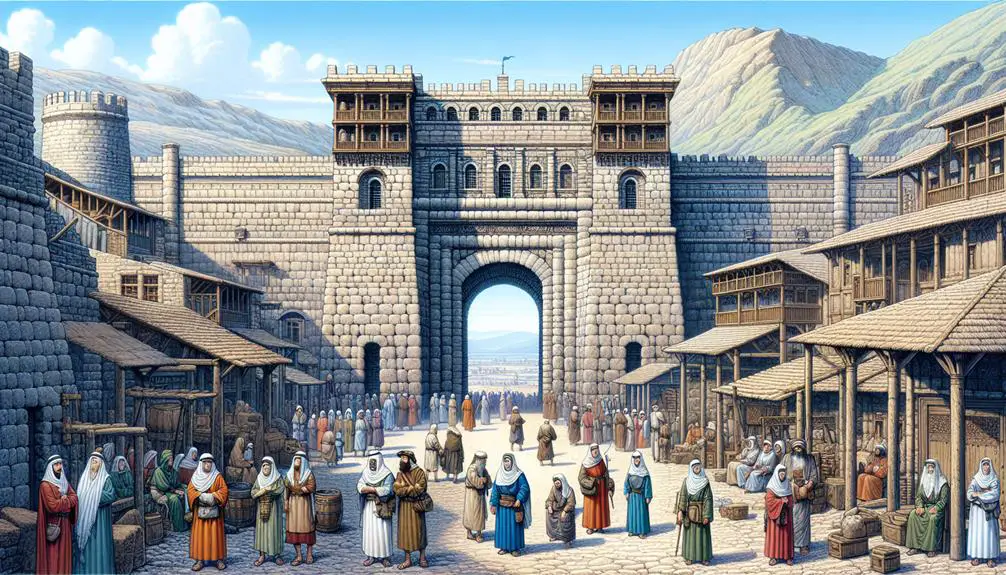
Bethshan in the Bible
Isn't it fascinating that just as you're exploring ancient cities, Bethshan comes into the conversation, a site of profound biblical significance yet often overlooked in casual discussions?
You've likely encountered its echoes in scriptures, where its layers of history and mystery beckon for a closer look. Situated strategically, Bethshan tells a tale of conquests, defeats, and resilience, offering a unique lens through which to view the complexities of ancient life and spirituality.
What secrets does Bethshan hold about the cultural and civilizational shifts over millennia? Let's uncover the story together, where each piece of unearthed pottery and scripture verse adds depth to our understanding of this ancient city.
Key Takeaways
- Bethshan is identified in religious texts, underlining its historical and spiritual significance.
- Archaeological findings at Bethshan provide insights into its biblical era culture and rituals.
- The city's strategic position made it a focal point for military conquests mentioned in the Bible.
- Bethshan served as a hub for cultural and economic exchanges, as noted in biblical narratives.
Location and Historical Overview
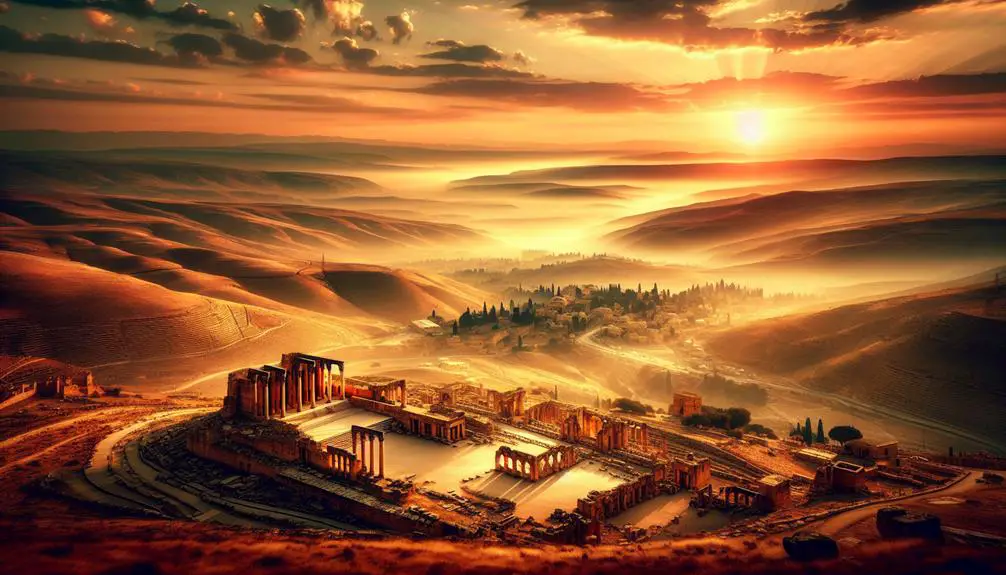
Bethshan, nestled in the fertile Jordan River Valley, has served as a significant crossroads of culture and history throughout the annals of time. Its strategic location bridged ancient civilizations, facilitating trade, military campaigns, and cultural exchange. The modern identification of Bethshan correlates with the archaeological site of Beit She'an, revealing layers of human occupation that span millennia. This identification is crucial for historical accuracy, providing a tangible link to the narratives and events documented in ancient texts.
The geological features of the area around Bethshan have played a pivotal role in its historical significance. The city is situated at the confluence of the Jordan River Valley and the Jezreel Valley, creating a natural passageway between the sea and the interior of the region. This unique positioning not only made Bethshan a vital trade hub but also a strategic military site. The fertile lands surrounding it contributed to its economic prosperity, supporting diverse agricultural activities over the centuries.
Bethshan's archaeological remains, enhanced by modern identification efforts, offer a window into the past, showcasing the city's evolution through different eras. The layers of ruins reflect a tapestry of cultural influences, from Egyptian and Canaanite to Greek, Roman, and beyond. These findings underscore Bethshan's role as a melting pot of civilizations, where diverse groups coexisted and interacted.
In analyzing Bethshan's location and historical overview, one appreciates its significance beyond the biblical narrative. Its geological features and modern identification provide insights into the socioeconomic and strategic factors that shaped its development, making it a key subject of study in understanding the ancient Near East.
Bethshan in Biblical Times
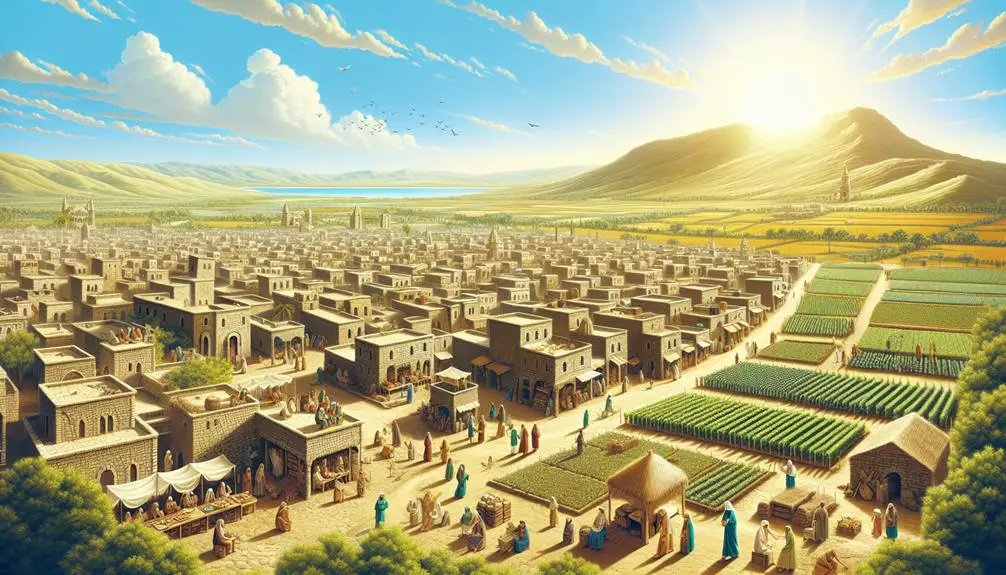
In biblical times, this city played a pivotal role as a backdrop to numerous significant events and narratives, illustrating its importance within the ancient scripts. Bethshan's urban development and religious significance are evident through the narratives and historical records, which highlight its strategic location and multifaceted role in the region.
Bethshan's evolution from a Canaanite city to a significant urban center under various empires underscores its importance in ancient urban development. Its strategic position along trade routes facilitated not only economic prosperity but also cultural exchanges, contributing to its diverse and rich urban fabric. This city's layers of habitation and governance reflect the complexities of ancient urban development, where political, economic, and cultural forces intertwined.
The city's religious significance is also noteworthy. Bethshan served as a venue for pivotal religious events and narratives, reflecting its role in the spiritual landscape of the time. Its mention in religious texts underscores the city's importance in the religious consciousness of the region, serving as a tangible link between the divine and the earthly realms.
Aspect |
Significance |
|---|---|
Urban Development |
Illustrates the city's growth, strategic importance, and role in ancient trade networks. |
Religious Significance |
Highlights Bethshan's role in religious narratives and its spiritual importance to the people. |
Cultural Exchange |
Reflects the city's position as a melting pot of cultures due to its strategic location. |
Historical Events |
Emphasizes Bethshan's involvement in significant historical and biblical events. |
Bethshan's story in biblical times offers a fascinating glimpse into the ancient world, showcasing the intricate relationship between urban development, religious significance, and historical narratives.
Archaeological Discoveries
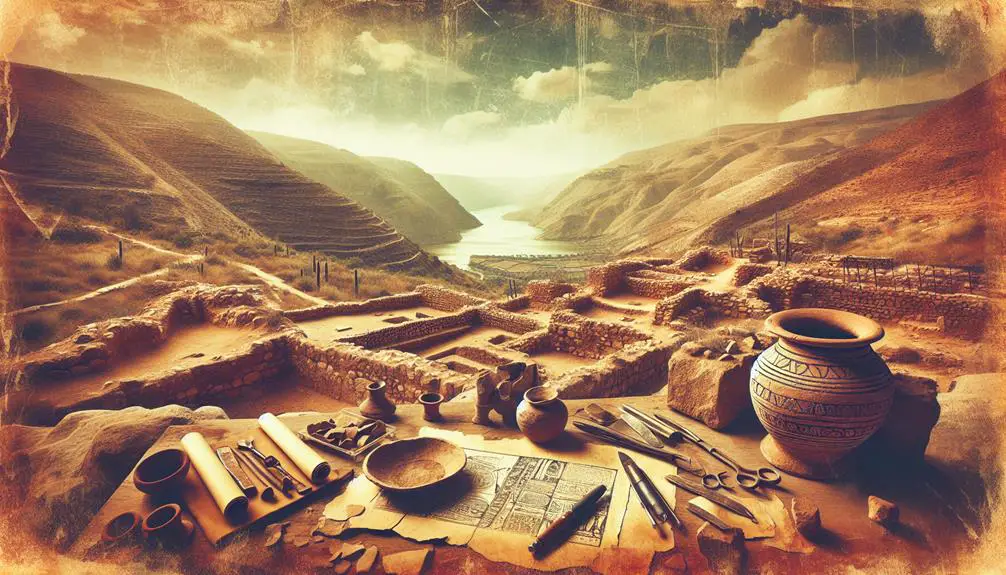
Recent excavations at the ancient site reveal a wealth of archaeological findings, shedding light on Bethshan's significant role throughout history. The meticulous application of modern excavation techniques has allowed archaeologists to uncover artifacts with minimal damage, enhancing our understanding of the city's extensive past. These techniques, ranging from precise digging methods to advanced scanning technologies, have facilitated the discovery of objects that provide insight into the daily lives, trade practices, and religious rituals of its ancient inhabitants.
Artifact preservation has been a critical component of the Bethshan excavations. Specialists in conservation have employed a variety of methods to ensure that these invaluable items withstand the threats of decay and environmental damage. From the initial moment of unearthing, each artifact undergoes a detailed examination and cleaning process, followed by stabilization procedures that guarantee its longevity for future study and display. This careful approach to preservation not only safeguards the physical artifacts but also the rich history they embody.
The artifacts discovered at Bethshan span several historical periods, offering a tangible connection to the city's multifaceted narrative. Among these findings are pottery shards that hint at domestic life and trade relations, tools that speak to the technological advancements of the time, and inscriptions that provide clues to the linguistic and cultural practices of its inhabitants.
These archaeological discoveries at Bethshan are instrumental in piecing together the city's past, allowing historians and archaeologists to construct a more nuanced understanding of its role in the ancient world. Through the combined efforts of excavation techniques and artifact preservation, Bethshan's story continues to unfold, offering profound insights into its historical significance.
The Conquest by King Saul
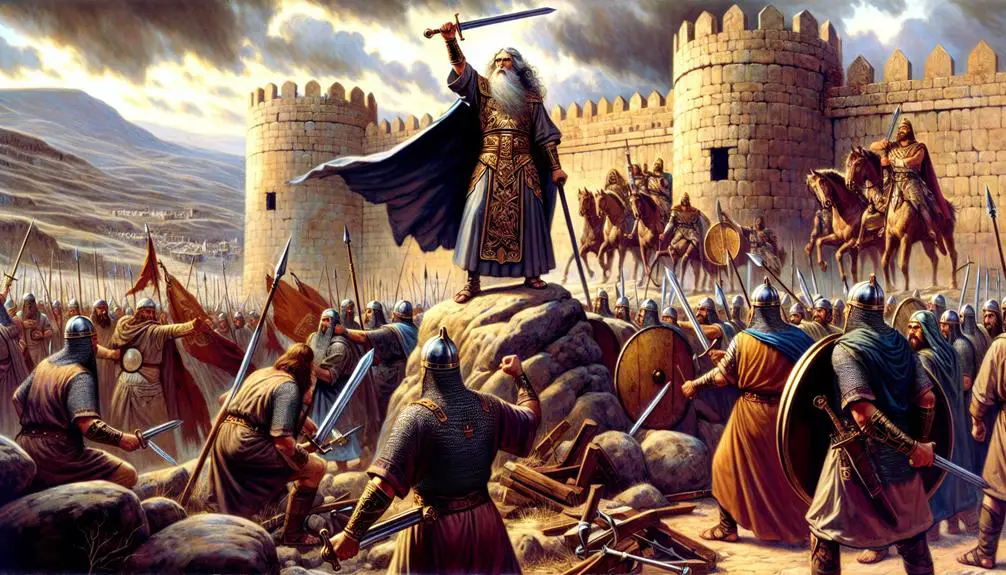
You must consider King Saul's military strategy to understand his victory at Bethshan. This analysis reveals the strategic significance of Bethshan in the broader context of Saul's military campaigns.
Examining these facets sheds light on the tactical decisions that led to his conquest.
Saul's Military Strategy
King Saul's military strategy, marked by its bold and innovative tactics, played a pivotal role in his conquests and the expansion of Israelite territory. His approach was multifaceted, combining armor innovations with diplomatic alliances that bolstered his army's capabilities and reach.
Saul understood the value of integrating advanced armor technology, which not only protected his soldiers more effectively but also intimidated his adversaries. Additionally, he recognized the power of forming alliances, strategically aligning Israel with neighboring states to consolidate strength and share resources.
This blend of technological advancement and political acumen allowed Saul to navigate the complex geopolitical landscape of the time, securing victories that would have been unattainable through traditional warfare alone. His methods set a precedent for military leadership in the ancient world.
Victory at Bethshan
Saul's conquest of Bethshan represents a critical juncture in Israelite military history, showcasing his strategic finesse and tactical innovation. His understanding of enemy tactics and adaptation to the battlefield dynamics were pivotal. The victory not only bolstered Israel's territorial claims but also reshaped the regional power balance.
Aspect |
Analysis |
|---|---|
Enemy Tactics |
Saul anticipated and countered effectively. |
Strategic Moves |
Innovative maneuvers isolated Bethshan. |
Tactical Innovation |
Used terrain and intelligence for advantage. |
Post Battle Rituals |
Cemented morale and deterred future threats. |
Outcome |
Significant shift in regional power dynamics. |
This victory underscored the importance of adaptability and intelligence in warfare, setting precedents for post battle rituals that reinforced group cohesion and deterred enemy incursions.
The City's Strategic Importance
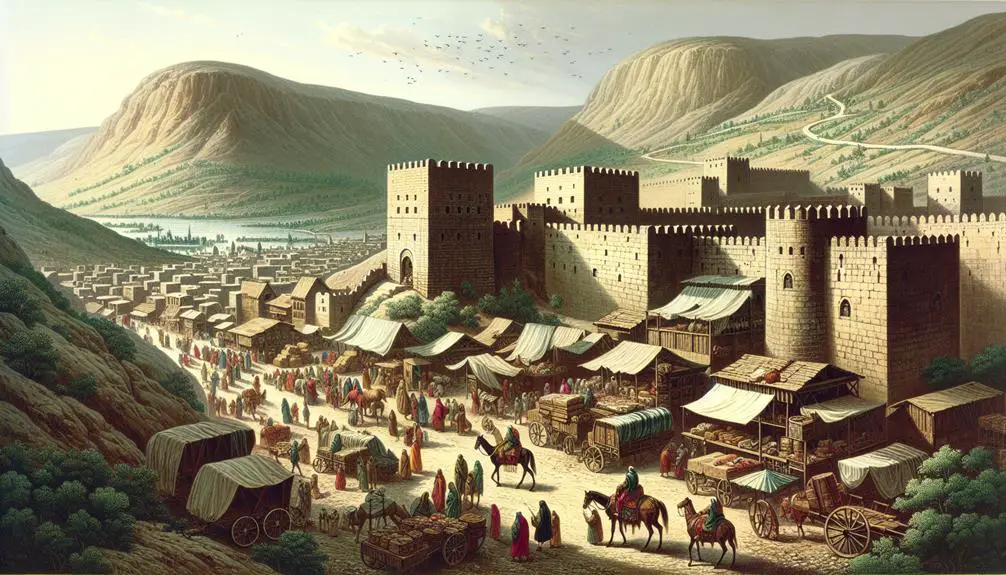
Bethshan's strategic importance in ancient times stemmed primarily from its location at the crossroads of key trade routes connecting Egypt and Mesopotamia. This unique positioning not only facilitated trade and cultural exchanges but also made the city a coveted prize for various powers seeking control over the fertile crescent. The convergence of these routes at Bethshan provided an unparalleled advantage in terms of economic prosperity and strategic military positioning.
The city's defensive features further underscored its significance. Nestled on a hill, Bethshan offered natural protection against invaders, allowing its inhabitants to monitor and control the movement along these critical pathways. The terrain around Bethshan included steep slopes, making any direct assault particularly challenging. Moreover, the city's fortifications, which evolved over centuries, reflected the importance of defending this hub of commerce and communication.
Control over Bethshan meant dominance over the surrounding regions and facilitated easier mobilization of troops and resources between Asia and Africa. This strategic leverage made Bethshan a focal point in the power dynamics of the ancient Near East. Empires and kingdoms understood that possessing Bethshan could significantly alter the balance of power in their favor, leading to numerous conflicts centered around this pivotal city.
In essence, Bethshan's position at the heart of vital trade routes and its formidable defensive features not only contributed to its prosperity and development but also to its historical significance as a battleground for empires. Its strategic importance was unmatched, making it a key player in the narrative of the ancient world.
Cultural and Civilizational Layers
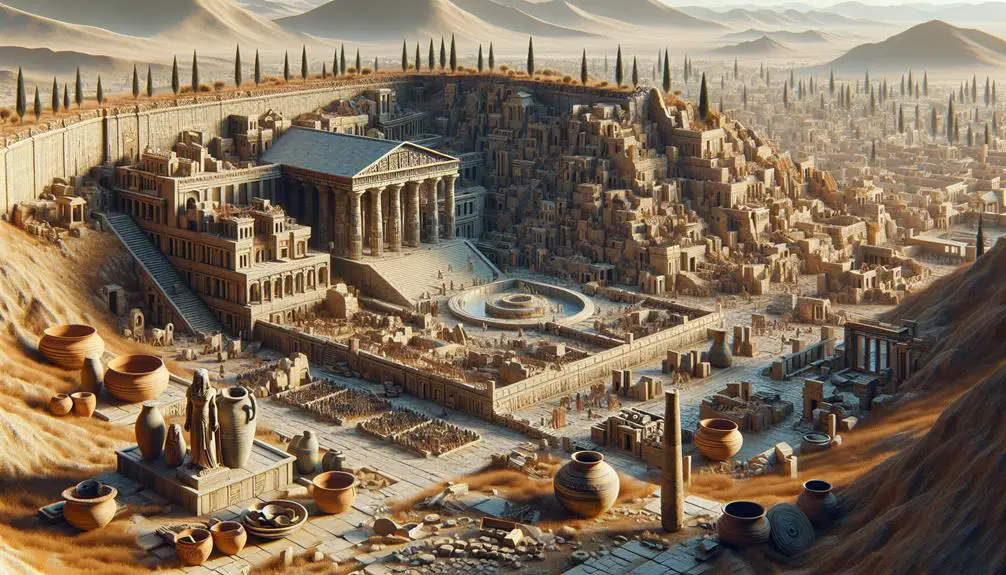
The excavation of Bethshan reveals a mosaic of cultural and civilizational layers, showcasing its role as a crossroads for diverse peoples and traditions throughout history. This confluence of cultures has significantly influenced its urban development and architectural styles, making Bethshan a unique testament to the complexities of historical interaction and exchange.
As you delve deeper into the layers, you'll notice:
- Prehistoric settlements: The earliest layers hint at rudimentary urban development, where simple dwellings and communal spaces suggest a nascent society engaging with its environment and neighbors.
- Ancient empires: The influence of Egyptian, Assyrian, and later Roman control is evident in the sophisticated urban planning and architectural styles. Public buildings, streets, and fortifications reflect the strategic importance of Bethshan, as well as the imposition of foreign administrative and cultural norms.
- Medieval modifications: Despite the city's ancient origins, the medieval period introduced new architectural styles and urban developments, reflecting the changing dynamics of power, religion, and trade in the region.
Analyzing these layers, it's clear that Bethshan's urban development wasn't static but evolved through interactions with various civilizations. Each layer contributed to the city's complex identity, from the layout of its streets and the construction of its buildings to the cultural practices of its inhabitants. The architectural styles found in Bethshan are particularly telling, offering a visual narrative of influence and adaptation. This diversity not only highlights the city's historical significance but also underscores the importance of preserving such sites for future study and appreciation.
Bethshan's Legacy in Christianity
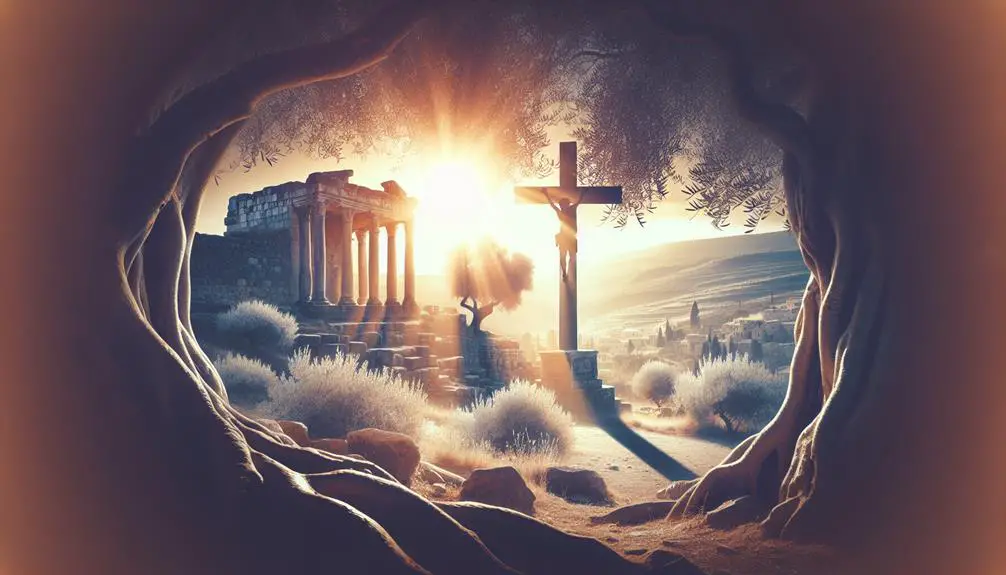
Delving into Bethshan's Christian heritage reveals a profound transformation from a site of ancient conquests to a beacon of spiritual significance. This change underscores the city's role in the narrative of Christian interpretations, where religious symbolism often intertwines with historical events to convey deeper theological insights.
Bethshan's mention in Christian texts doesn't merely recount its historical significance; it imbues the location with layers of religious symbolism that resonate with the Christian faith. For instance, the city's transition from a battleground to a place of peace mirrors the Christian journey from sin to salvation, highlighting a theme of redemption that's central to Christian doctrine. This metaphorical representation allows believers to draw parallels between the physical restoration of Bethshan and the spiritual renewal experienced through faith in Christ.
Moreover, Bethshan's archaeological layers, revealing a tapestry of various civilizations, serve as a testament to the Christian belief in the universality of God's message. Each layer, with its own story, contributes to the understanding of how Christian teachings have traversed cultures and epochs, emphasizing the religion's adaptability and enduring relevance.
In analyzing Bethshan's legacy in Christianity, it's crucial to acknowledge how the city's rich history and religious symbolism contribute to contemporary Christian thought. The site's transformation from a place marked by conquest to one of spiritual significance provides a powerful narrative of redemption and renewal, themes that are at the heart of Christian interpretations. Bethshan thus serves not only as a historical landmark but also as a source of inspiration and reflection for the Christian community.
Frequently Asked Questions
How Has the Interpretation of Bethshan's Role and Significance Evolved in Modern Biblical Scholarship?
You've seen how interpretations of Bethshan's significance have shifted with modern biblical scholarship. Archaeological evidence and textual analysis have been crucial in this evolution. They've allowed scholars to peel back layers of history, revealing a more nuanced understanding of its role.
This evidence has challenged previous assumptions, highlighting Bethshan's strategic and cultural importance in a broader historical context. Your grasp of this subject reflects an appreciation for the dynamic nature of scholarly inquiry.
Are There Any Specific Myths or Legends Associated With Bethshan That Are Not Found in the Biblical Texts?
You're diving into a rich world where archaeological finds unearth stories untold in ancient texts. When exploring myths or legends beyond biblical narratives, Bethshan's soil whispers secrets.
These tales, carved not in scripture but in the layers of the earth, offer a unique glimpse into past lives. Cultural interpretations of these discoveries challenge and enrich our understanding, bridging gaps between historical events and mythical lore, revealing a multifaceted view of ancient societies.
How Has the Local Climate and Geography Influenced the Development and Decline of Bethshan Throughout History?
Bethshan's development and decline have been deeply influenced by its local climate and geography. The region's agricultural practices thrived due to fertile land and reliable water sources, playing a critical role in its growth.
However, these same factors also made it vulnerable to natural disasters and shifts in climate, which, over time, contributed to its decline. Understanding these dynamics offers insights into the broader impacts of environmental changes on historical settlements.
What Role Did Bethshan Play in the Economic Trade Routes of the Ancient Near East?
Imagine you're analyzing a key trade hub in the ancient Near East.
Bethshan played a pivotal role, acting as a crossroads for major routes. Its strategic location influenced not just trade but also architectural findings and military strategies, reflecting its economic significance.
Archeological evidence shows how the city's design and fortifications catered to its role in trade networks, underscoring its importance in regional commerce and defense mechanisms in an analytically objective manner.
Can Any Parallels Be Drawn Between the Societal Structure of Bethshan and That of Contemporary Cities in the Region During Its Peak Periods?
You can indeed find parallels between Bethshan's societal structure and those of contemporary cities in its peak periods. By examining urban governance, you'll notice similar administrative frameworks aimed at managing trade and social order.
Additionally, architectural styles in Bethshan mirrored regional trends, reflecting a shared cultural and technological heritage. This comparison not only highlights the interconnectedness of ancient cities but also underscores the influence of broader regional developments on local urban planning and design.
Conclusion
In the tapestry of history, Bethshan stands as a vibrant thread, weaving together narratives of conquest, resilience, and faith. Through its ruins, you're reminded of humanity's quest for dominance and the transient nature of power.
Archaeological findings reveal layers of civilization, each adding depth to our understanding of ancient societies. As a symbolic bridge between past and present, Bethshan's legacy in Christianity illuminates the enduring influence of sacred landscapes.
Its story, rich in lessons, continues to inspire scholarly exploration and spiritual reflection.

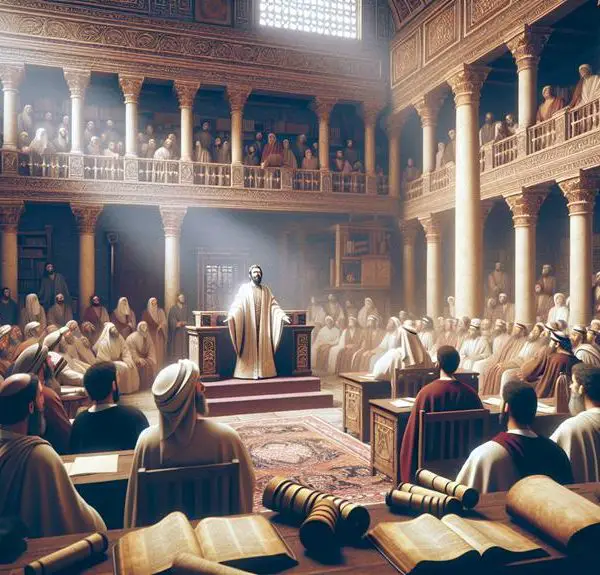

Sign up